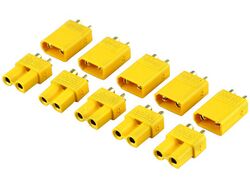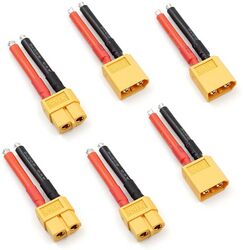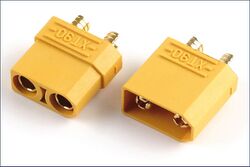Batteries: Difference between revisions
No edit summary |
mNo edit summary |
||
| (15 intermediate revisions by 3 users not shown) | |||
| Line 6: | Line 6: | ||
=== Cells === |
=== Cells === |
||
First up is picking the number of cells in your battery. The number of cells also defines the voltage range your battery operates at. Most robots in the 3lb weight class use 3 or 4 cells. This is abbreviated as 3S or 4S. The standard nominal voltage is 3.7 Volts per cell. |
First up is picking the number of cells in your battery. The number of cells also defines the voltage range your battery operates at. Most robots in the [[3lb Weight Class|3lb weight class]] use 3 or 4 cells. This is abbreviated as 3S or 4S. The standard nominal voltage is 3.7 Volts per cell. |
||
'''Nominal voltage''' is the voltage when the battery is about 40% state of charge. A typical nominal voltage is 3.7 Volts per cell. The nominal voltage is the voltage that is usually printed on the battery. This is also the best voltage to keep the battery at for long term (months) storage. |
'''Nominal voltage''' is the voltage when the battery is about 40% state of charge. A typical nominal voltage is 3.7 Volts per cell. The nominal voltage is the voltage that is usually printed on the battery. This is also the best voltage to keep the battery at for long term (months) storage. |
||
| Line 30: | Line 30: | ||
| 6S || 22.2 Volts || 18.0 Volts || 25.2 Volts |
| 6S || 22.2 Volts || 18.0 Volts || 25.2 Volts |
||
|} |
|} |
||
| ⚫ | |||
| ⚫ | MaH or AH is a measure of how much energy a battery holds (1000 MaH = 1 AH). The measurement is supposed to align the amount of power the battery could deliver at its nominal voltage for one hour. So a 3S 500 Mah battery should be able to provide 500 Milliamps of current at 11.1volts for 1 hour. For example it's a reasonable assumption that a 3S 500 Mah battery should be able to provide 5 Amps (5000 Milliamps) for 6 minutes. |
||
| ⚫ | |||
| ⚫ | MaH or AH is a measure of how much energy a battery holds. The measurement is supposed to align the amount of power the battery could deliver at its nominal voltage for one hour. So a 3S 500 Mah battery should be able to provide 500 Milliamps of current at 11.1volts for 1 hour. For example it's a reasonable assumption that a 3S 500 Mah battery should be able to provide 5 Amps (5000 Milliamps) for 6 minutes. |
||
'''C rating''' is maximum safe discharge rate. It would let us know if the above draw of 5 amps was okay. To determine the maximum safe amp draw it is the Capacity (C) times the C rating number. So if our 3S 500 Mah battery had a C rating of 20 the maximum safe amps we could draw would be (500 Mah x 20) 10,000 Milliamps or 10 amps. Which gives us a good safety margin around a 5 amp draw. Some batteries list a fixed and burst C rate. Battery manufactures tend to over state their C rating. It is best to ensure your robots max power draw will be safely under the C rating for your battery. |
'''C rating''' is maximum safe discharge rate. It would let us know if the above draw of 5 amps was okay. To determine the maximum safe amp draw it is the Capacity (C) times the C rating number. So if our 3S 500 Mah battery had a C rating of 20 the maximum safe amps we could draw would be (500 Mah x 20) 10,000 Milliamps or 10 amps. Which gives us a good safety margin around a 5 amp draw. Some batteries list a fixed and burst C rate. Battery manufactures tend to over state their C rating. It is best to ensure your robots max power draw will be safely under the C rating for your battery. |
||
=== Connector === |
=== Connector === |
||
[[File:Lipo-battery-connectors.png||center|Common Connectors]] |
|||
When it comes to how to connect your battery to your robot there are a lot of options. It is best to chose something that can make a firm connection and can handle the amount of current you will draw. |
When it comes to how to connect your battery to your robot there are a lot of options. It is best to chose something that can make a firm connection and can handle the amount of current you will draw. |
||
Some Common Connector types |
Some Common Connector types |
||
*XT30 |
*XT30 |
||
*XT60 (NHRL Favorite, Very common) |
|||
*XT60 |
|||
*XT90 |
*XT90 |
||
*Deans |
*Deans |
||
*JST (Not recommended.. these fall out or make poor connections easily) |
|||
*JST |
|||
<gallery widths=250px heights=250px> |
|||
File:Xt30-connector-pair.jpg|frameless|XT30 connectors are ideal for 3lb robots, but may be too small for 12lb or 30lb batteries |
|||
File:61Ss+QNjzmL. AC SL1000 .jpg|frameless|Pre-soldered XT60 connectors are good for the robot side of a battery connection in all weight classes |
|||
File:Xt90-high-current-connectors-pair-female-male-446-17-B.jpg|frameless|XT90 connectors are best used on bigger robots, such as 12lbs or 30lbs |
|||
</gallery> |
|||
=== Combining Batteries === |
|||
You can combine multiple batteries to reach a higher voltage or capacity. One common example is for competitors to combine two 2S batteries in series, '''always of the same capacity''' to make a 4S power system. It is also possible to combine batteries in parallel to double the capacity instead of the voltage. When combining batteries it is incredibly important to always make sure the batteries have the same capacity. |
|||
== Charging Batteries == |
|||
[[File:D2 02.jpg|thumb|right|ISDT Dual Balance Charger (D2)]] |
|||
LiPo Batteries are typically made up of multiple cells. Charging is more complicated than a simple NiCad or NiMH battery. It is '''highly''' recommended that you use a balance charger to charge your battery. Balance chargers ensure that each cell is charged to the proper voltage. Without this it is possible for one cell to become over or undercharged cells. Overcharged cells release hydrogen and prone to '''catch fire!''' A balance charger greatly reduces this risk. It is very important to never charge LiPo Batteries unattended, most battery fires happen during charging, not during use! |
|||
===Common Charger Settings=== |
|||
'''Volts per Cell''' - 4.2v - Don't go higher unless you have special batteries. |
|||
'''Charge Current''' - Playing it safe, you want to charge at 1C (The Mah Rating of your battery.) You can usually cheat this up a bit to decrease charging time, but the more you do the shorter the life of your battery will be. Don't ever go above 5C. |
|||
===Battery Aging=== |
|||
All LiPo Batteries have a limited lifespan. There are several factors that effect a battery’s useful capacity over time. You can actually measure this degradation by looking at the batteries internal resistance. This is typically measured in MilliOhms. As a batteries internal resistance rises more heat is generated during discharge. Interestingly as a battery heats up its internal resistance drops. This heat is lost energy that will not flow into your robot. Higher internal resistance will also make the battery more prone to 'Voltage Sag' which is a momentary drop in voltage during high current draw. |
|||
====Factors that reduce a battery’s capacity==== |
|||
* Discharging a battery below its empty voltage |
|||
* Current draw above a battery’s C rating |
|||
* High Temperatures (LiPo Batteries age faster but preform better when warm) |
|||
* Charge Cycles (Hoppy LiPo batteries are only good for a few hundred charge / discharge cycles) |
|||
* Time (Depending on the temperature and state of charge a battery may lose up to 20% of its capacity per year) |
|||
Combat robots can be particularly hard on LiPo batteries. Typically bot builders will design their bots to have the smallest possible battery that will still last a full match. Any extra battery weight is weight that wasn't put into a weapon or defense. Draining a LiPo completely in 3 or 4 minutes is not a kind thing to do to a battery. It's best not to get too attached to any one battery. It's reasonable to expect that a competitive robot will need new LiPo batteries every year. Older batteries that are still safe can go on to live lives in less strenuous robots or even radio transmitters. |
|||
== Battery Safety == |
|||
The energy density of LiPo Batteries is about 1/3 that of TNT. Each battery is by nature unstable chemistry. The batteries used in Combat Robots typically have no internal protections (due to the high draw use case) and if mishandled can explode or catch fire. It's very important to respect and understand this danger and know when a battery has reached the end of its safe useful life. |
|||
When a Battery is no longer safe |
|||
* Any battery that has sustained damage or cuts to the metal foil that holds the cells. |
|||
* Puffy batteries. Batteries that are starting to fail will start to fill with hydrogen gas. This will make the battery puffy. A little puffy is likely OK for a few more matches.. but a very puffy battery is no longer safe |
|||
* Batteries which cannot be charged. If the charger rejects the battery due to bad cell voltage its not longer safe |
|||
* Batteries with bare balance leads or bare leads are a short circuit risk. Short Circuit = FIRE. Fix or dispose of right away. |
|||
* Batteries that have become too hot to touch are no longer safe |
|||
== Battery Disposal / Safe-ing == |
|||
When batteries are no longer safe or are dead they need to be rendered inert (Safe-d) and disposed of. The salt water method is a very safe and low work way to render a battery inert. |
|||
{{#ev:youtube|WLIeQOgPmBE|||Salt Water Discharge Method}} |
|||
[[Category:Information]] |
|||
Latest revision as of 19:51, 13 August 2025
Almost all robots who compete in combat robots derive the majority of their power from Batteries. A decade ago it was popular to see Sealed Lead Acid batteries as the primary battery in many robots. Today the vast majority of Robots use Lithium Polymer or LiPo batteries. Lithium Batteries allow for a large amount of power to be stored in a relatively small volume. This article will only focus on Lithium Batteries as they are the most common.
How To Pick the Right Battery
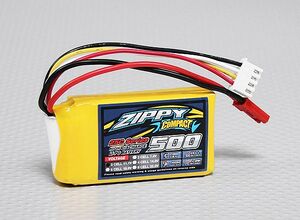
LiPo Batteries come in a variety of sizes and capacities. Finding the right battery for your robot will depend on how much power you need and how much space and weight you have.
Cells
First up is picking the number of cells in your battery. The number of cells also defines the voltage range your battery operates at. Most robots in the 3lb weight class use 3 or 4 cells. This is abbreviated as 3S or 4S. The standard nominal voltage is 3.7 Volts per cell.
Nominal voltage is the voltage when the battery is about 40% state of charge. A typical nominal voltage is 3.7 Volts per cell. The nominal voltage is the voltage that is usually printed on the battery. This is also the best voltage to keep the battery at for long term (months) storage.
Empty Voltage is when the battery has no more usable capacity left. This voltage is typically 3.0 volts per cell. If you continue draw power from an empty battery the voltage will rapidly drop to 0 volts. Batteries discharged below 3.0 volts per cell (will be damaged, and you may not be able to charge them again. Even if recharged, these batteries will likely have a higher internal resistance and a reduced capacity.
Full Voltage is the voltage when the battery is charged to is maximum capacity. This voltage is typically 4.2 Volts per cell. Charging the battery beyond this voltage will damage the battery and may cause a fire!
| Cells | Nominal Voltage | Empty Voltage | Full Voltage |
|---|---|---|---|
| 1S | 3.7 Volts | 3.0 Volts | 4.2 Volts |
| 2S | 7.4 Volts | 6.0 Volts | 8.4 Volts |
| 3S | 11.1 Volts | 9.0 Volts | 12.6 Volts |
| 4S | 14.8 Volts | 12.0 Volts | 16.8 Volts |
| 5S (Rare) | 18.5 Volts | 15.0 Volts | 21 Volts |
| 6S | 22.2 Volts | 18.0 Volts | 25.2 Volts |
MaH (Milliamp Hours)
MaH or AH is a measure of how much energy a battery holds (1000 MaH = 1 AH). The measurement is supposed to align the amount of power the battery could deliver at its nominal voltage for one hour. So a 3S 500 Mah battery should be able to provide 500 Milliamps of current at 11.1volts for 1 hour. For example it's a reasonable assumption that a 3S 500 Mah battery should be able to provide 5 Amps (5000 Milliamps) for 6 minutes.
C rating is maximum safe discharge rate. It would let us know if the above draw of 5 amps was okay. To determine the maximum safe amp draw it is the Capacity (C) times the C rating number. So if our 3S 500 Mah battery had a C rating of 20 the maximum safe amps we could draw would be (500 Mah x 20) 10,000 Milliamps or 10 amps. Which gives us a good safety margin around a 5 amp draw. Some batteries list a fixed and burst C rate. Battery manufactures tend to over state their C rating. It is best to ensure your robots max power draw will be safely under the C rating for your battery.
Connector

When it comes to how to connect your battery to your robot there are a lot of options. It is best to chose something that can make a firm connection and can handle the amount of current you will draw.
Some Common Connector types
- XT30
- XT60 (NHRL Favorite, Very common)
- XT90
- Deans
- JST (Not recommended.. these fall out or make poor connections easily)
-
XT30 connectors are ideal for 3lb robots, but may be too small for 12lb or 30lb batteries
-
Pre-soldered XT60 connectors are good for the robot side of a battery connection in all weight classes
-
XT90 connectors are best used on bigger robots, such as 12lbs or 30lbs
Combining Batteries
You can combine multiple batteries to reach a higher voltage or capacity. One common example is for competitors to combine two 2S batteries in series, always of the same capacity to make a 4S power system. It is also possible to combine batteries in parallel to double the capacity instead of the voltage. When combining batteries it is incredibly important to always make sure the batteries have the same capacity.
Charging Batteries
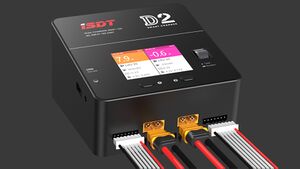
LiPo Batteries are typically made up of multiple cells. Charging is more complicated than a simple NiCad or NiMH battery. It is highly recommended that you use a balance charger to charge your battery. Balance chargers ensure that each cell is charged to the proper voltage. Without this it is possible for one cell to become over or undercharged cells. Overcharged cells release hydrogen and prone to catch fire! A balance charger greatly reduces this risk. It is very important to never charge LiPo Batteries unattended, most battery fires happen during charging, not during use!
Common Charger Settings
Volts per Cell - 4.2v - Don't go higher unless you have special batteries.
Charge Current - Playing it safe, you want to charge at 1C (The Mah Rating of your battery.) You can usually cheat this up a bit to decrease charging time, but the more you do the shorter the life of your battery will be. Don't ever go above 5C.
Battery Aging
All LiPo Batteries have a limited lifespan. There are several factors that effect a battery’s useful capacity over time. You can actually measure this degradation by looking at the batteries internal resistance. This is typically measured in MilliOhms. As a batteries internal resistance rises more heat is generated during discharge. Interestingly as a battery heats up its internal resistance drops. This heat is lost energy that will not flow into your robot. Higher internal resistance will also make the battery more prone to 'Voltage Sag' which is a momentary drop in voltage during high current draw.
Factors that reduce a battery’s capacity
- Discharging a battery below its empty voltage
- Current draw above a battery’s C rating
- High Temperatures (LiPo Batteries age faster but preform better when warm)
- Charge Cycles (Hoppy LiPo batteries are only good for a few hundred charge / discharge cycles)
- Time (Depending on the temperature and state of charge a battery may lose up to 20% of its capacity per year)
Combat robots can be particularly hard on LiPo batteries. Typically bot builders will design their bots to have the smallest possible battery that will still last a full match. Any extra battery weight is weight that wasn't put into a weapon or defense. Draining a LiPo completely in 3 or 4 minutes is not a kind thing to do to a battery. It's best not to get too attached to any one battery. It's reasonable to expect that a competitive robot will need new LiPo batteries every year. Older batteries that are still safe can go on to live lives in less strenuous robots or even radio transmitters.
Battery Safety
The energy density of LiPo Batteries is about 1/3 that of TNT. Each battery is by nature unstable chemistry. The batteries used in Combat Robots typically have no internal protections (due to the high draw use case) and if mishandled can explode or catch fire. It's very important to respect and understand this danger and know when a battery has reached the end of its safe useful life.
When a Battery is no longer safe
- Any battery that has sustained damage or cuts to the metal foil that holds the cells.
- Puffy batteries. Batteries that are starting to fail will start to fill with hydrogen gas. This will make the battery puffy. A little puffy is likely OK for a few more matches.. but a very puffy battery is no longer safe
- Batteries which cannot be charged. If the charger rejects the battery due to bad cell voltage its not longer safe
- Batteries with bare balance leads or bare leads are a short circuit risk. Short Circuit = FIRE. Fix or dispose of right away.
- Batteries that have become too hot to touch are no longer safe
Battery Disposal / Safe-ing
When batteries are no longer safe or are dead they need to be rendered inert (Safe-d) and disposed of. The salt water method is a very safe and low work way to render a battery inert.
